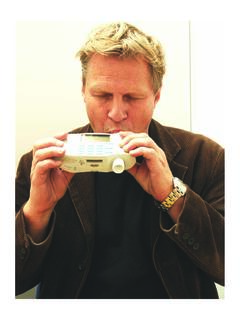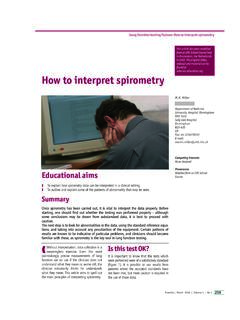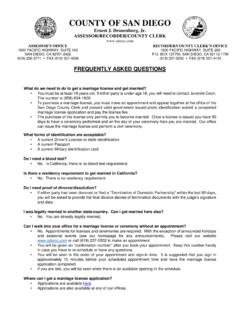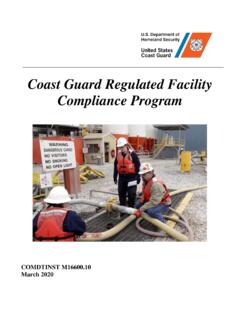Transcription of Air pollution: from sources of emissions to health effects
1 air pollution :from sources of emissions to health effects109 Breathe | December 2004 | Volume 1 | No 2 REVIEWINSERM U472, Epidemiology ofAllergic and Respiratory Diseases(EPAR), Villejuif, : C. P nard-MorandINSERM U472, EPAR Dept16, Avenue Paul Vaillant CouturierF94807 VillejuifFranceFax: 33 aims To provide a thorough presentation of sources , dispersion and transformation of major air pol-lutants. To describe the health effects of these air pollutants. To explain the differences between emissions , immissions, exposure and absorbed dose. To help readers to understand what is at stake in the topical scientific and political debate onair pollution , particularly in urban areas, constitutes a public health concern, as it has aharmful effect on the health , survival and activities of humans and other living , the main types of air pollution commonly found in urban environments are pre-sented, along with their sources , levels of emissions , mechanisms of dispersion, transfor-mation, concentrations in ambient air (=immissions), and effects on the environment andhealth.
2 In particular, the concepts of exposure, absorbed dose and individual susceptibil-ity are explained. The recent evolution in air pollutant emissions and immissions due tothe growing weight of road traffic is also described. Finally, European air quality criteriaare P nard-MorandI. Annesi-MaesanoKey points Immissions (=concentrationof air pollutants in the ambi-ent atmosphere) result fromthe intensity and the type ofemissions of air pollutants,the dispersion of air pollu-tants and their transporta-tion. The main air pollution indica-tors are SO2, NOx, PM, CO,VOC and O3. Road traffic has become thefirst source of air pollution inurban areas. health effects caused by airpollutants depend on theabsorbed dose, the type ofpollutants and the individualsusceptibility. All chemical, biological and physical agentsthat modify the natural characteristics ofthe atmosphere are referred to as air pollu-tants.
3 Air pollutants arise both from naturalprocesses (volcanic activities, oceans, forests,etc.) and human activities (fossil fuel combus-tion, transportation, power plant emissions oremissions from other industrial processes). Airpollutants can be classified as either primary orsecondary. Primary pollutants are substancesdirectly produced by a process, such as ash froma volcanic eruption or carbon monoxide gasfrom a motor vehicle exhaust. Primary pollu-tants can be transformed in the loweratmosphere by solar radiation and heat intosecondary pollutants, such as ozone (O3) andother photochemical article briefly describes major air pollu-tants, by presenting their sources , dispersion,transformation, immission (concentration of airpollutants in the ambient air), and potentialeffects on health and the environment. sources of airpollutionSources of air pollution [1] include naturalsources [2] and human-made sources [3].
4 Natural sourcesNaturally occurring particulate matter (PM)includes dust from the earth s surface (crustalmaterial), sea salt in coastal areas and biologi-cal material, in the form of pollen, spores orplant and animal debris [1]. Volcanic eruptionscan introduce very important quantities ofgases and particles into the atmosphere. Forexample, the Etna volcano emits 3,000 tons ofsulphur dioxide (SO2) on an average day andup to 10,000 tons during periods of great activ-ity. During the cataclysmic eruptions of theTambora in 1815 in Indonesia, 100 billion tonsof volcanic products were ejected into theatmosphere, 300 million tons of which reachedthe stratosphere, which resulted in a mean tem-perature fall of ~ C over the whole Earth. Insome rural areas, periodic forest fires producelarge amounts of PM. Other natural sources of air pollution include:thunderbolts, which produce significant quanti-ties of oxides of nitrogen (NOx); algae on thesurface of the oceans, which give out hydrogensulphide (H2S); wind erosion, which introducesparticles into the atmosphere; and humid zones,such as swamps, peat-bogs or little deep lakes,which produce methane (CH4).
5 Low concentrations of O3occur naturally atground level, formed in the presence of sunlightby reactions between NOxand volatile organiccompounds (VOCs).Human-made sourcesIn urban areas, most air pollution comes fromhuman-made sources . Such sources can be classi-fied as either mobile (cars, trucks, air planes,marine engines, etc.) or point source (factories,electric power plants, etc.). To date, road traffic constitutes the majorsource of air pollution in the large cities of indus-trialised countries. Combustion of carbon-constituted fuels (coal, fuel oil, wood, natural gas)is never complete, and it produces carbon mon-oxide (CO) and hydrocarbons. NOxresult from thecombination of air nitrogen and oxygen fromcombustion of fossil fuels contained in motor fuelat high temperature. Human activities have increased the amountof VOCs due to petroleum, chemical industriesand transportation, and NOxfrom combustion inpower stations and automobiles.
6 Consequently,O3is more concentrated and more smog occurs indensely populated and industrial regions. Humanactivities contribute to total ambient PM. In urbanenvironments, particles arise mainly as a result ofcombustion from mobile and stationary and sulphur from fuel oils oxidise into are fuels that are used to move, warm upand get the necessary energy to the many indus-trial processes. Moreover, the industry producessome specific pollutants as waste, such as fluorinederivatives or aluminium. Ore treatment gives out heavy metals, suchas cadmium, zinc and lead. Mercury is producedby domestic garbage incineration. Agriculture, bythe utilisation of nitrogen fertilisers, generatesnitric oxide (N2O), a greenhouse effect gas, andammonia (NH3), which participate in the pro-cesses of acidification. CH4, another greenhouseeffect gas, is produced mainly by digestion andevacuation of farming animals.
7 sources of main air pollutionindicatorsThere are too many pollutants in the atmospherefor all of them to be monitored. Among them,some pollutants are monitored because they arecharacteristic of a particular pollution (releasedby industrial plants or motor vehicles) andbecause they are known or suspected to causedetrimental effects on the environment and/orhealth. These pollutants are called air pollutionindicators [4 6].Figure 2 provides an example of the sectorialdistribution of French emissions in 2002. Data istaken from The Centre InterprofessionnelTechnique d Etude de la pollution Atmosph rique(CITEPA; [Inter-professional Technical Centre for Research into air pollution ]). CITEPA regularly produces estimations ofquantities emitted into the atmosphere from dif-ferent sources for various substances; estimations are produced using arecognised methodology based on the CORINAIR system, developed by the European EnvironmentAgency.
8 110 Breathe | December 2004 | Volume 1 | No 2 REVIEWAir pollution : from sources of emissions to health effectsEMISSIONSTRANSPORTDISPERSIONTRANS FORMATIONIMMISSIONSP rimary pollutantsNOx, SO2, PM, VOCWindTemperature gradientAtmospheric pressureSun / HumiditySecondary pullutantsphoto oxidant (O3)Primary pollutants +Secondary pollutantsUrban air pollutionBackground air pollutionSO2 VOCPMSO2 VOCPMNOxVOCCOPMO3 VOCDEPOSITIONWet deposition: rain, snowDry depositionFigure 1 The structure of this article isbased on the air pollutant indicators monitored in Europe include: Sulphur dioxide (SO2) Nitrogen oxides (NOx) Particulate matter (PM10, ) Ozone (O3) Carbon monoxide (CO) Volatile organic compounds (VOCs) Several toxic metals, such as lead, arsenic,cadmium, nickel or mercury ( quicksilver ).111 Breathe | December 2004 | Volume 1 | No 2 REVIEWAir pollution : from sources of emissions to health effectsNMVOC (1542 kt)Lead (217 kt)CO (5954 kt) (274 kt)PM10 (518 kt)NOx (1351 kt)SO2 (537 kt)020 40 60 80100 Distribution %Energy transformationAgriculture/forestryReside ntial/tertiaryOther transportManufacturing industryRoad transportFigure 2 Sectorial distribution ofemissions in 2002 in mainlandFrance.
9 Main air pollutionindicatorsSulphur dioxide (SO2)In France, 85% of SO2emissions come from theuse of sulphur-containing fossil fuels (fuel oil andcoal). These emissions are mainly released intothe atmosphere by petroleum refining (24% ofemissions in mainland France in 2002), produc-tion of electricity (16%) and heating systems(figure 2). The diesel motor vehicle sector is alsoresponsible for a minor part of oxides (NOx)In 2002, road traffic was responsible for releas-ing 48% (16% for diesel truck traffic) of NOxemissions in mainland France, followed by agri-culture/forestry, the manufacturing industryand energy transformation (figure 2). Particulate matter (PM)PM is a complex mixture of solid particles and li-quid droplets suspended in the air that vary in size,composition and concentration. PM is usefullyclassified by size. PM with a mass median aerody-namic diameter <10 m (PM10; big particles) canstay in the air for minutes or hours and can travelas little as 100 yards or as much as 30 miles, (fine particles) are lighter and stay in the airfor days or weeks longer and travel farther.
10 Thesources of airborne PM comprise of the manufac-turing industries, public buildings and the worksector, specifically agriculture/forestry (particu-larly ploughing) (31% of PM10emissions inmainland France in 2002), domestic heating sys-tems and the incineration of waste. However,airborne particles are also released by motor ve-hicles, mainly diesel engines (13% of the PM10emissions in mainland France in 2002 and 20%of the ) (figure 2).Ozone (O3)Most O3comes from vehicular traffic during monoxide (CO)CO is a gas that comes from incomplete combus-tion. In 2002, 34% of CO emissions in mainlandFrance were generated by road traffic. The manu-facturing industries and the residential/tertiarysector both come in second position, contributing26% of emissions . Urban, collective or individualheating constitute the main part of the residen-tial/tertiary sector contribution (figure 2).








